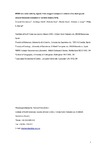Mostrar o rexistro simple do ítem
ENSO and Solar Activity Signals From Oxygen Isotopes in Diatom Silica During Late Glacial-Holocene Transition in Central Andes (18°S)
| dc.contributor.author | Hernández, Armand | |
| dc.contributor.author | Giralt, Santiago | |
| dc.contributor.author | Bao, Roberto | |
| dc.contributor.author | Sáez, Alberto | |
| dc.contributor.author | Leng, Melanie | |
| dc.contributor.author | Barker, Philip | |
| dc.date.accessioned | 2024-03-22T18:27:27Z | |
| dc.date.available | 2024-03-22T18:27:27Z | |
| dc.date.issued | 2010-02 | |
| dc.identifier.citation | Hernández, A., Giralt, S., Bao, R. et al. ENSO and solar activity signals from oxygen isotopes in diatom silica during late glacial-Holocene transition in Central Andes (18°S). J Paleolimnol 44, 413–429 (2010). https://doi.org/10.1007/s10933-010-9412-x | es_ES |
| dc.identifier.issn | 1573-0417 | |
| dc.identifier.uri | http://hdl.handle.net/2183/35968 | |
| dc.description | Postprint (accepted version) of the document published in: https://doi.org/10.1007/s10933-010-9412-x | es_ES |
| dc.description.abstract | [Abstract] The late glacial-Holocene transition from the Lago Chungará sedimentary record in northern Chilean Altiplano (18°S) is made up of laminated sediments composed of light-white and dark-green pluriannual couplets of diatomaceous ooze. Light-white sediment laminae accumulated during short-term extraordinary diatom blooms whereas dark-green sediment laminae represent the baseline limnological conditions during several years of deposition. Diatom oxygen isotope ratios (δ18Odiatom) from 40 consecutive dark-green laminae, ranging from 11,990 to 11,450 cal year BP, show that a series of decadal-to-centennial dry–wet oscillations occurred. Dry periods are marked by relatively high isotope values whereas wet episodes are indicated by lower values. This interpretation agrees with the reconstructions of terrigenous inputs and regional effective moisture availability carried out in the lake but there is a systematic temporal disagreement between them owing to the non-linear response of the lacustrine ecosystem to environmental forcings. Furthermore, the δ18Odiatom record tracks effective moisture changes at a centennial scale. Three major phases have been established (11,990–11,800, 11,800–11,550, and 11,550–11,450 cal year BP). Each phase is defined by an increasing isotope trend followed by a sudden depletion. In addition, several wet and dry events at a decadal scale are superimposed onto these major trends. Spectral analyses of the δ18Odiatom values suggest that cycles and events could have been triggered by both El Niño-Southern Oscillation (ENSO) and solar activity. Significant ENSO frequencies of 7–9 years and 15–17 years, and periodicities of the solar activity cycles such as 11 years (Schwabe), 23 years (Hale) and 35 years (Brückner) have been recognised in the oxygen isotope time series. Time–frequency analysis shows that although solar and ENSO forcing were present at the onset of the Holocene, they were more intense during the late glacial period. The early Holocene might have been mainly governed by La Niña-like conditions that correspond to wet conditions over the Andean Altiplano. | es_ES |
| dc.description.sponsorship | The Spanish Ministry of Science and Innovation funded the research at Lago Chungará through the projects ANDESTER (BTE2001-3225), Complementary Action (BTE2001-5257-E), LAVOLTER (CGL2004-00683/BTE), GEOBILA (CGL2007-60932/BTE) and CONSOLIDER-Ingenio 2010 GRACCIE (CSD2007-00067). A. Hernández have benefited from a FPI grant from The Spanish Ministry of Science and Innovation. The Limological Research Center (USA) provided the technology and expertise to retrieve the cores. We are grateful to CONAF (Chile) for the facilities provided in Chungará. The NIGL (UK) funded the isotope analysis, and Hilary Sloane is specially thanked for assistance with the diatom oxygen isotope measurements. | es_ES |
| dc.language.iso | eng | es_ES |
| dc.publisher | Springer | es_ES |
| dc.relation | info:eu-repo/grantAgreement/MICYT/Plan Nacional de I+D+i 2000-2003/BTE2001-3225/ES/ | es_ES |
| dc.relation | info:eu-repo/grantAgreement/MICYT/Plan Nacional de I+D+i 2004-2007/CGL2004-00683/ES/FENOMENOS EXTREMOS EN EL REGISTRO SEDIMENTARIO DE LAGOS EN CONTEXTO VOLCANICO-HIDROTERMAL ACTIVO/ | es_ES |
| dc.relation | info:eu-repo/grantAgreement/MEC/Plan Nacional de I+D+i 2004-2007/CGL2007-60932/ES/RECONSTRUCCION PALEOCLIMATICA DE ALTA RESOLUCION DESDE EL ULTIMO MAXIMO GLACIAR BASADA EN INDICADORES GEOQUIMICOS Y BIOLOGICOS DE LAGOS ANDINOS Y DEL OCEANO PACIFICO/ | es_ES |
| dc.relation | info:eu-repo/grantAgreement/MEC/Plan Nacional de I+D+i 2004-2007/CSD2007-00067/ES/MULTIDISCIPLINARY RESEARCH CONSORTIUM ON GRADUAL AND ABRUPT CLIMATE CHANGES, AND THEIR IMPACTS ON THE ENVIRONMENT (GRACCIE)/ | es_ES |
| dc.relation.uri | https://doi.org/10.1007/s10933-010-9412-x | es_ES |
| dc.rights | © 2010, Springer Science Business Media B.V. | es_ES |
| dc.subject | Lake | es_ES |
| dc.subject | Oxygen isotopes | es_ES |
| dc.subject | Late glacial | es_ES |
| dc.subject | Holocene | es_ES |
| dc.subject | Andean Altiplano | es_ES |
| dc.subject | ENSO | es_ES |
| dc.subject | Solar activity | es_ES |
| dc.subject | Diatoms | es_ES |
| dc.title | ENSO and Solar Activity Signals From Oxygen Isotopes in Diatom Silica During Late Glacial-Holocene Transition in Central Andes (18°S) | es_ES |
| dc.type | info:eu-repo/semantics/article | es_ES |
| dc.rights.access | info:eu-repo/semantics/openAccess | es_ES |
| UDC.journalTitle | Journal of Paleolimnology | es_ES |
| UDC.volume | 44 (2010) | es_ES |
| UDC.issue | 2 (August) | es_ES |
| UDC.startPage | 413 | es_ES |
| UDC.endPage | 429 | es_ES |
| dc.identifier.doi | 10.1007/s10933-010-9412-x |
Ficheiros no ítem
Este ítem aparece na(s) seguinte(s) colección(s)
-
GI-GRICA - Artigos [49]






